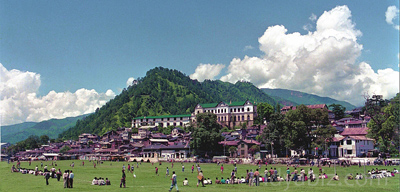 |
|
 |
|
Chamba  The town of Chamba, the district headquarter of Chamba district is situated in the western Himalayas between north latitudes 32°10' and 33°13' and east longitudes 75°45' and 77°33'. The town stands on a plateau on the right bank of the Ravi river valley between Dhauladhar and Zanskar ranges south of the inner Himalayas. This town was founded by Raja Sahil Varman when he conquered the lower Rani valley from the petty chiefs called Ranas and Thakurs in the beginning of 10th Century. It seems the original name of the town was Champa as mentioned in Kalhan's Rajtarangani. In the bansauli or genealogical rolls of the Chamba Rajas a reference occurs of place which was adorned with highly fragrant Champaka trees and guarded by Goddess Champavati or more popularly known as Chameshni. The temple was built by Sahil Varman in the honour of his daughter Champavati who is worshipped as a goddess in Chamba. Champavati temple became the family temple of the ruling family.
General information
Area: 6528 sq. km
Population 4.60 lakh
Season: The best tourist season to visit Chamba is round the year. Adventure tourists may like to undertake winter trekking from November to March when the higher reaches of the district are snow clad and access to most of the villages is on foot.
Climate: The climate of Chamba in general is tempreate with well defined seasons. However, there may be variations because of micro-climatic systems depending upon altitude and mountain aspect. The winters last from December to February. March and April generally remain cool and dry but snowfall does occur at higher elevations during these months. The temperature begins to rise rapidly from the middle of April till last week of June or first week of July when monsoon breaks-in. Monsoon continues till the end of August or mid September. During the monsoon, the weather remains misty, humid and cloudy. October and November are comparatively dry but cold. The maximum temperature in Chamba town in summers is 38°C and the minimum in winter is 0°C.
Approach: Chamba is approximately 52 kms from Dalhousie. The distance is reduced by 6 kms. via Upper Barkota and Khajjiar road. Bus and taxi service is available from Chamba to Pathankot, Delhi, Dharamsala, Shimla, Chandigarh, Jammu and most of the Punjab cities along the national highway. Places to Visit Near Chamba Akhand Chandi Palace 1Km.
Bhuri Singh Museum 0Km.
Bhamaur 65 Km.
Champavati temple 0Km.
Chamunda Devi Temple 3Km.
Chaugan 0Km.
Dalhousie 52Km.
Hari Rai Temple 0Km.
Kilar (Pangi Valley HQ) 173Km.
Laxmi Narayan Temple 0Km.
Manimahesh 100Km.
Rang Mahal 1Km.
Saho 20Km.
Sui Mata Temple 2Km.
Vajreshwari temple 1Km.
Akhand Chandi palace
Construction of this residential building of the Chamba family was started by Raja Umed Singh sometimes between 1748-1764 AD. The place was rebuilt and renovated during the reign of Raja Sham Singh with the help of British engineers. The Darbar Hall (Marshal Hall) was built in 1879 by Capt. Marshal and the Zanana Mehal was added in the reign of Raja Bhuri Singh. The subsequent additions and alterations clearly betray the Mughal and the British influence. In 1958 the Palace building was sold by the descendants of the royal family to the Himachal Government. The latter handed it over to the Education Department for the purpose of starting a Government College and District Library. The palace has a commanding view of the Chaugan, Laxmi Narayana Temple, Sui Mata, Chamunda Devi Temple, Rang Mehal, Hari Rai Temple and Bansi Gopal Temple.
Bharmaur
65 kms from Chamba is the land of legendary Gaddies, i.e. Bharmaur. Known as Brahmpur in the 6th century, was the seat of power of Chamba state for some 400 years till AD 920, when a new capital was founded at Chamba by Raja Sahil Varman. Bharmaur is known for some very old archaeological remains, primarily the temples. All these temples stand on a level area which call the Chaurasi after the 84 Siddhas who are believed to have meditated in Bharmaur over 1000 years ago. These Siddhas hailed from Kurukshetra and visited
Manimahesh. The oldest temples in the complex are those of Lakshna Devi and Ganesh. Both these temples are made in the hill style with gable roofs and rubble masonry. The outer facade, the inner facade of sanctum, circum ambulatory path and the ceiling are exquisitely carved. The idol of Lakshna Devi in her incarnation as Mahisasurmardini is magnificent.
The tallest temple in the whole complex is of Manimahesh built in Shikhara style of architecture. The temple has a Shivalingam on a raised platform. The other temple in Shikhara style is of Nar Singh. Lord Vishnu in his avtar as Nar Singh has been cast vividly. There is a bronze Nandi of life size which stands facing the Manimahesh temple. Inscriptions on the pedestal of the bull and on the idols of Lakshna Devi and Ganesh date back to the reign of Raja Meru Varman. These idols are believed to be the work of master craftsman Gugga. There is a small water source called Ardh Ganda in a corner of the temple complex. Bathing in its water is considered religiously significant. The country around Bharmour is regarded as belonging to Shiva and is sometimes called Shiv-Bhumi. Being the home of nomadic shepherds Gaddies it is also called Gadderan. Just 4 kms above Chaurasi temples is the hill temple of Bharmani Devi. A trek to this temple refreshes the visitors as it unfolds the green woods before him. The best period to visit Bharmour is between July and September.
There is PWD Rest-House and a Lodge for accomodation. A number of hotels, sarais and a mountaineering hut with dormitory facility for 26 persons is coming up at Bharmour. There is a regional centre of Mountaineering Institute, Manali, where courses are conducted by qualified trainers. Bharmour is also known for its delicious apples and local blankets.
Champavati temple
This temple is located behind the City Police Post and Treasury building. As mentioned earlier the temple was built by Raja Sahil Varman in memory of his daughter Champavati who is believed to have influenced her father to set-up Chamba at its present location. The temple is in the Shikhara style with elaborate stone carving and the wheel roof. The size of this temple is equivalent to the largest of the Laxmi Narayana Temple.
Chamunda Devi temple chamba
This temple is located on the spur of the Shah Madar Hill overlooking the town to its south east. The temple stands on a raised platform. The temple has artistic carvings on its lintel, pillars and the ceiling. Behind the main temple is a small shrine of Lord Shiva in the Shikhara style. There is another platform in front of this temple where two very old peepul trees provide shelter to the visitors. From this platform a bird's eye view of most of the land marks in the town including Chaugan, Circuit House, most of the temples and river Ravi can be had. The temple is being looked after by Archaeological Survey of India.
This temple can be approached by road from Chamba (3 kms). It lies on the right hand side of the Chamba-Jhamwar road. School going children and pilgrims prefer to take the flight of steps from Sapri to this temple. There steps were got constructed by Raja Raj Singh (1764-1794 AD). The temple is an ideal picnic spot throughout the year because it has an easy approach and a commanding view.
The Chaugan
The Chaugan is the heart and hub centre of all activities in Chamba. Tradition is silent as to its use as a polo ground and the name is etymologically distinct from Chaugan, the Persian name of Polo, being of Sanskrit origin and meaning 'four-sided'. Initially the five Chaugan were a single patch of meadow. In 1890s the leveling of the Chaugan was done. It became a public promenade and Cricket ground for the British. Annual Minjar Mela is held in the Chaugan. Local people can be seen promenading in the Chaugan till late night.
Chaurasi temples
The 9th century temples at Bharmaur are among the most important early Hindu temples in the Chamba Valley. According to legend, 84 (chaurasi) yogi's visited Bharmaur, capital of King Sahil Varma. They were so pleased with the king's humility and hospitality that they blessed him with ten sons and a daughter, Champavati. A cluster of shrines commemorates that visit. The temple square is the Centre of all activities in the little town of Bharmaur and the Lakshmi, Ganesh, Manimahesh and Narsing temples, the main shrines, are splendidly set off by the dramatic mountainscape.
Chhatrari
45 kms from Chamba via road is this famous village of Chhartrari. The village is inhabited mostly by the Gaddies who are semi-postral lot engaged in rearing of sheep and goats. This village, situated at a height of 6000 feet, its famous for its remarkable hill-style temple of Shamti Devi. The temple of Chhatrari is regarded as one of the holiest ones competing with well known temples of "Lakshna Devi" at Bharmour and of "Bhawani" at Kangra. The construction of the temple is simple. It consists of a small Cell or sanctuary in which one of the rare brasses by the master craftsman Gugga is enshrined. The walls of the temple are built of rubble masonry alternating with beams of wood. The structure is surmounted by a sloping roof of slate. The roof is supported by richly craved wooden posts which form a VARANDAH or circumambulatory path round the sanctum. The Shakti Devi temple is of interest owning to the elaborate decoration of its facade, ceiling and pillar. The sanctum, its architecture and sculpture betray a conscious effort on part of its builder to introduce a highly refined post Gupta art in this remote part of Chamba.
The main idol in the temple is that Shakti. This fine brass statue, 4 feet 6 inches tall shows Shakti holding in her hands a lance (Power, energy) and a lotus (life), a bell (aether, space) and a snake (death and time). Besides this main idol there are almost thirty other small figurines of tutelary deities like Annapurna. Some of these are believed to have been brought from far South or the State of Orrisa. According to the inscription at Chhatrari the temple was built by Raja Meru Varman, by whose order the inscription was engraved alongwith the names of his father, grand father and great grand father as well as that of the sculptor. This epigraph commemorates Meru Varman's victory over his rivals with the help of the Devi. The outer walls of the sanctum are covered with frescoes which are of recent origin and represent scenes from PURANAS.
Near the Shakti Devi Temple is the temple of Gauri Shankra. The stone image of Gauri Shankra is of later origin. The work can be attributed to the 10th century AD which indicates a long period of sculptural activity in the region. A few minutes walk up the mountain slopes from the main village is the Charauta temple which houses a stone image of BHATOD NAG who gives water to the people in return for one black and four white goats every three years. There are two interesting legends connected with the village. Villagers had to fetch water from a nearby village call Makain. Once, a Chela of a siddha while carrying water fell prey to bears. The Siddha invoked the deity to solve the water problem. Inspired by the Devi he made 36 marks with his trident at different places in the village and water gushed out from the points where the marks had been made. There are 36 water sources in the village around which beautiful PANIHARS (Fountain slabs) can be seen.
According to J. Hutchison the village was named Chhatrari at a later date when Raja Bala Bhadra (1589-1611) made a grant of 36 LARHIS to the temple following an accidental death of a cow at the hands of the Raja. One larhi is equal to three acres of land and such Lahris are today known as Chhatrari.
In the month of September a mela is held on the third day after the mela at the Mani-Mahesh lake whence a man brings a Lota of water with which the idol of Shakti is bathed. On this day a number of sheep are slain to appease the goddess and to invoke her blessings. After the prayer the gaddies in their traditional costumes dance to the tune of local music. The village is approached either from Gehra from where a bridle path leads to Chhatrari or from Luna-Ka-Pul from where a steep trace is to be ascended to reach the village or by the motorable road, experiencing a scary ride almost 700 to 900 feet above the river Ravi as one nears the village. The ascent on foot is most rewarding as the visitors are welcomed by lush green fields and orchards at the outskirts of Chhatrari. Chhatrari looks most scenic during September and October. Even on other occasions, particularly in spring, Chhatrari offers pleasant scenery.
Hari Rai temple
This temple is dedicated to Lord Vishnu and dates back to 11th century. It was probably built by Salabahana. This temple lies in the north-west corner of the main Chaugan, which had became the official entrance to the town by the end of 19th C. A steep path leads to the old Shitla bridge, which was constructed in the year 1894. The temple is built in Shikhara style and stands on a stone platform. The Shikhara of the temple is finely carved. This is one of the major old temples, which is away from the old township and the only one near the Chaugan. Much of this temple is hidden behind some unimaginative structures of the British period behind the Gandhi Gate and the Fire Station Building. The Gandhi Gate was built in the year 1900 to welcome Lord Curzon, Viceroy. It is the only structure that has been coated with saffron colour and stands out because of its prominent colour. The temple enshrines a marvellous bronze image of Lord Vishnu in the form of Chaturmurti. The temple of Hari Rai is believed to be of great antiquity and legend affirms that the Ravi once flowed in a shallow stream across the Chaugan and the temple had to be approached by stepping stones.
Kalatop
Kalatop and Khajiar are best explored if you take a three days walk from Dalhousie to Kalatop, Khajjiar and back Dalhousie.The trek is more or less level and requires good health, a pair of sturdy walking shoes. Kalatop is 10 kms from G.P.O. at an altitude of 8000 feet. Walking along the secluded and forested road through upper Nakorota hills, one reaches Lakkarmandi. Between G.P.O. and Lakkarmandi lies the Dalhousie water system, Tibetan Handicraft Centre and Dalhousie Potato Farm at Ahla. Lakkarmandi is nestled between 8600 feet high DayanKund peak on its right and Kalatop on the left. Dayan Kund has military installations and is closed to civilians except the local people who visit Bhulwani Mata temple near DayanKund. Lakkarmandi is home for dhogri families that are engaged in charcoal making. Most of the dhogris have been driven to plains because of the fall in the demand for charcoal.
At Lakkarmandi there is a Wildlife Barrier to check movement of vehicles on the unpaved but narrow level road that runs 3 kms to Kalatop Forest Rest House. The walk from Lakkarmandi to Kalatop is through dense forest of pines and deodars. The solitude is occasionally broken by singing birds. The blissful solitude of Kalatop is ideal for the honeymooners. Permit for the rest house is obtainable from DFO, Wildlife, Chamba.
Lakshimi Narayan temple
Laxmi Narayana Temple, which is the main temple of Chamba town was built by Sahil Varman in the 10th century AD. The temple has been built in the Shikhara style. The temple consists of Bimana i.e. Shikhara and GarbhGriha with a small antralya. Laxmi Narayana Temple has a mandapa like structure also. The wooden Chhattries, the shell roof, atop the temple were in response to the local climatic conditions as a protection against snowfall.
There are several other temples within the complex. The temple of Radha krishna, Shiva Temple of Chandergupta and Gauri Shankar Temple are among these. The temple of Laxmi Narayana continued to be embellished by the Rajas who succeeded to the throne of Chamba. Raja Balabhadra Verma perched the metallic image of Garuda on a high pillar at the main gate of the temple. Raja Chhatra Singh place gilded pinnacles on the temple tops in 1678 as a reaction against the orders of Aurangzeb to demolish the temple. Later Rajas also added a shrine or two, thus enriching the complex.
Rang mahal
One of the largest monuments, Rang Mahal is located in Surara Mohalla. The foundation of Rang Mahal was laid by Raja Umed Sing (1748-1764). The super structure of Rang Mahal, which is in brick belongs to a later date with its southern portion built around 1860 by Raj Sri Singh. The architecture of Rang Mahal is an amalgam of Mughal and British styles. This palace was the residence for a branch of the ruling family. Its fort like looks justify its use as royal granary and treasury which is on its western side. Once the palace must have hummed with activity of busy servant and the frolics of the royal blood but now under the aegis of Handicrafts Department of the State Government, most of the rooms of this palace are being used as work-shops for making shoes, chapples and rumals. A number of decorative and colorful wall painting have been removed and taken to National Museum of Delhi. Some of the wall paintings and richly painted doors of the palace can be seen preserved in the Bhuri Singh Museum of Chamba.
Mani-Mahesh
In the month of August/September the famous JATRA of Mani-Mahesh commences from Laxmi-Narayana Temple in Chamba. The CHHARI is taken to the sacred lake of Mani-Mahesh, which is one of the chief tirthas in the district. Off late people from north India and beyond have started visiting this sacred lake. According to an estimate nearly one lakh people visit this sacred lake every year and take a holy dip. The lake is situated at the height of 13,500 feet above sea level and at the base of Mani-Mahesh Kailsah peak (18,564 feet). Mani-Mahesh kailash is a virgin peak. In 1968 an Indo-Japanese team led by Nandini Patel made an unsuccessful attempt to scale the peak. The devout attribute the failure to the divine prowesses of the holy mountain. On the margin of the lake is a small marble Shivlaing called
CHAUMUKHA. Mani-Mahesh is 35 kms. from Bharmour. During mela days efficient bus service is available upto Hadsar. The pilgrimage is generally done in two stages. First camp is set-up at Dhanchho. Several grazers can be seen grazing their sheep in the alpine pastures of this place. the ascent from Chanchho to Mani-Mahesh lake is difficult in patches. Just short of the lake is Gauri Kund where women take a holy dip before returning to home. The pilgrimage to Mani-Mahesh is considered sacred like that of Amarnath, Badrinath and Rameshwarm. During the mela days several BHANDARAS are set-up for the benefit of pilgrims and meals are served free of cost. Pack animals are also available for those who do not want to carry their luggage themselves.
Minjar
Minjar is the most popular fair of Chamba which is attended by a large number of people from every nook and corner of the district. This mela is held on the second Sunday of the Shravana month. The fair is announced by distribution of Minjar which is a silk tassel worn on some parts of the dress by men and women alike. This tassel symbolises the shoots of paddy and maize which make their appearance around this time of the year. The week long fair begins when the Minjar flag is hoisted in historical Chowgan. The town of Chamba wears a colourful look with every person turning out in best attire. Most part of the Chowgan is converted into markets and people do brisk business during this week. Sports and cultural programmes are organised. On the third Sunday the gaiety, colourfulness and enthusiasm reaches its crescendo when the colourful Minjar procession of the deities accompanied by dancing troupes, traditionally attired locals, traditional drum beaters along with Police and Home Guards band, begins its march from Akhand Chandi Palace for the venue near the Police Lines Nalhora. A great concourse of people is already assembled there. Earlier the Raja and now the chief guest throws a coconut, a rupee, a seasonal fruit and a Minjar tied in a red piece of cloth - Lohan - as offering to the river. This is followed by all the people throwing their Minjars into the river. Traditional Kumjari-Malhar is sung by the local artists. Betal leaves and ittra are offered to everyone among the invitees as a gesture of respect and festivity. Untill 1943, a live buffalo used to be pushed into the river to propitiate it. It if was carried away and drowned, the event was regarded as propitious, the sacrifice having been accepted. If it crossed the river and reached the other bank, that also was auspicious as it was believed that all the sins of the town were transferred to the other side of the river.
Minjar fair has been declared as one of the state fairs of Himachal Pradesh. Wide coverage is given on TV and print media. Undoubtedly Chamba is at its very best during this fair that generally falls in the month of July/ August.
Saho
Twenty kms from Chamba is the village of Saho on the right bank of Sal river. The village is situated on a high plateau of great beauty. Saho is famous for its temple dedicated to Lord Chandra Shekhra i.e. the moon-crowned God, Shiva. The temple is hidden behind the locality in a tree grove. Two magnificent images of Shiva can be seen at the entrance and a huge Shivaling is enshrined in the sanctum. Facing the temple is a life size Nandi bull carved with fine details.
According to Sarahan Prasasti, "The temple was constructed by Stayaki, a local Rana in order to establish friendship between his wife Somprabha and the daughter Parvati". It is believed that the temple belongs to a period earlier than transfer of seat of power from Bharmour to Chamba in 10th century. In the month of August/ September a mela is held in the compound of the temple. This mela coincides with Manimahesh Yatra.
During summer Saho wears a golden mantle of wheat crop and in August/September the fields are lush green with paddy crop. The spring water of Saho is supposed to have medicinal value. There is a Forest Rest House at Saho.
Sui Mata temple
This temple can be divided into three parts which can physically spread apart. The temple of Sui Mata is on an elevation of Shah Madar Hill. A steep flight of steps comes down to a small pavilion just above the Saho road. From the Saho road the flight of steps continues down to the main town a little to the east of Chauntra Mohalla. At the end of the flight of steps there is another small pavilion with gargoyles with running water. The flight of stone steps to the aqueduct from the Sarota stream was built by Sarda, the Rani of Raja Jeet Singh (1794-1808). According to the legend when Raja Sahil Varman founded the town and made this aqueduct for water supply to the town the water refused to flow. It was ascribed to supernatural causes. It was prophasised that the spirit of the stream must be propitiated, and the Brahmins, on being consulted replied that the victim must either be the Rani or her son. Another tradition runs that the Raja himself had a dream in which he was directed to offer up his son, where upon the Rani pleaded to be accepted as a substitute. Thus on a appointed day the Rani along with her maidens was buried alive in a grave. The legend goes on to say that when the grave was filled in the water began to flow.
In memory of her devotion a small shrine was erected at that spot and mela called Sui Mata Ka Mela was also appointed to be held annually from 15th of Chait to the first of Baisakh. This fair is attended by women and children who in their best attire sing praises of the Rani and offer homage to the Rani for her singular sacrifice.
Vajreshwari temple
This ancient temple is believed to be 1000 years old and is dedicated to Devi Vajreshwari-Goddess of lightning. The temple is situated on the northern most corner of the town at the end of Jansali Bazar. No historical record of the temple is available. The temple is built in the Shikhara style with wooden Chhattries and stands on the platform. The Shikhara of the temple is elaborately carved. There are two other minor temples on either side of the main shrine.
See Also Haripurdhar Travel guide, Kheerganga Trek, Trekking Near Kasol, Activitities to do near kasol, kasol travel, Theog Travel Guide, Kasol Travel Guide How to visit Kasol, mini israeil in india, gateway to heaven, Weekend Getaways to Visit near Delhi , Tawang Travel Guide, Reckong Peo travel guide Reckong Peo hotels, Off beat Places near Shimla, Tourists places near shimla, Kalpa Travel Guide, Keylong Travel Guide, Joginder Nagar, Hamirpur, ManiMahesh, Trout Fishing in Rohru, Khara Pathar - Pabbar Valley, Kollam, Fort Kochi, Munnar The Hill station of Kerela, Bharmaur - Land of legendary Gaddies, Chattradi, Historical fort of Kangra, Masroor Rock-cut Temple, Pragpur heritage village, village tourism in pragpur, Lansdowne A Weekend Retreat, Rewalsar, Sarahan, kasauli , Dagshai - one of the oldest cantonment towns of Himachal Pradesh, Kaza Travel Guide Places to visit in Kaza, Karsog Travel Guide, Jantar Mantar Travel Guide Jaipur, Pink City Jaipur, Bharatpur Rajasthan Travel Guide, Bundi Travel Guide, Bikaner Travel Guide, Ajmer Travel Guide, Alwar Travel Information, Kashmir The Paradise on Earth, PAHALGAM The Valley of Shepherds, Gulmarg Travel Guide, Sonamarg The Meadow of Gold, Hangrang Valley Travel Guide, Charang Ghati Travel Guide, Nako Lake Travel Guide, Bhangal, Mcleodganj Travel Guide, Gushaini Travel Guide, Dashir Lake, Bhrigu Lake, Narkanda A Tourist Destination Of The British Times, Kasauli Tourists Attraction, Barot Travel Guide, places to visit near mandi, how to visit barot, Shoghi Travel Guide, Salogra Trekking Ecstasy, Rohru Travel Guide, Fagu, Bhandal Valley, Saho Travel Guide, Sarol Picnic Spot Near Chamba, Salooni Chamba Travel Guide, Nahan Shivalik Hills Gems, Places to visit in Sirmour, Sirmour, Tourist Places near kinnaur, Kinnaur, Bharmaur Kugti Udaipur Manali trek, Maidi to Nadaun Trek, Hamirpur- Deotsidh- Sri Naina Devi Trek, Kinner Kailash Parikrama Trek , Manali Hamya Herbal Trek, Morchella Trek, Dharamsala Chhota Bhangal over sari Pass Kullu, Wild Trek Kullu Valley, Chander Trail kullu Valley, Malana History Trek Kullu Valley, Hamta Trek Kullu Valley, Trekking routes in Himachal, Trout Fishing in Himachal Pradesh, Paragliding in Bir Billing, Shimla Travel Guide, Deotsidh Temple Cave temple of Baba Balak nath, SujanPur Tihra Travel Guide, Kungri Gompa Travel Guide, Dhankar monastery, Kunzum Pass Travel Guide, Kaza Spiti Travel Guide, Kibber-Khyipur, Chander Taal Travel Guide, Spiti Valley Travel Guide, Baijnath ancient Shiv temple, Palampur City of Tea Gardens, Tourist Places in himachal pradesh, Places of tourists interest near dharamshala, Dharamshala Travel Guide, Mysterious Skeleton Lake of Roopkund, Thanedar Famous For Apple Gardens, Kufri Travel Guide, Ranikhet Tourism Ranikhet Travel Guide, Naldehra, Tattapani Travel Guide, Great Himalayan National Park, Chamba Beautifull Valley of Himachal, Renukaji, how to visit renuka lake, tour to renukaji, Chail Travel Guide, Khajjiar The mini Switzerland of India, Dalhousie hill station full of colonial charm, Rajgarh The Peach Valley, Adventure Sports in Manali, Manali Travel Guide, Jim Corbett National Park Tourism Guide, Champawat Rich in Heritage and culture, Bhowali one of the picturesque towns of Nainital, Barkot Travel Guide, Yamunotri Travel Guide, Tehri Garhwal Travel Guide, Sattal Travel Guide, Roopkund Travel Guide, Rajaji National Park Tourism and Travel Guide, PINDARI GLACIER TREKKING GUIDE, Naukuchiatal Lake Travel Guide, Nainital Tourism Nainital Travel Guide, MILAM GLACIER TRAVEL GUIDE, Khirsu, Joshimath Popular pilgrimage centre, Hemkund Sahib, Pangi Valley, Haldwani Gateway of Kumaon, Gopeshwar - Famous for Temples and Natural Beauty, Gangotri Travel Guide, Devprayag The last Prayag of Alaknanda, Abbott Mount picturesque and hidden destination, Fascinating place on the earth - Chamoli, Auli The popular skiing destination, Kausani The Switzerland of India , |
|
|
|
|
|
|
|
All Rights Reserved. Indyabiz.comÂ







